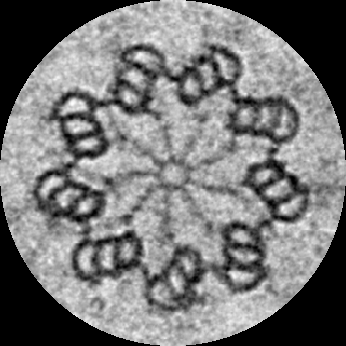Beyond genes: Are centrioles carriers of biological information?

Centrioles are barrel-shaped structures inside cells, made up of multiple proteins. They are currently the focus of much research, since mutations in the proteins that make them up can cause a broad range of diseases, including developmental abnormalities, respiratory conditions, male sterility and cancer. Publishing in Cell Research, EPFL scientists show that the original centrioles of a fertilized egg, which only come from the father, persist across tens of cell divisions in the developing embryo. The surprising finding raises the possibility that centrioles may actually be carriers of information, with profound implications for biology and disease treatment.
Perhaps best known for their role in cell division, centrioles ensure that chromosomes are properly passed on to the new daughter cells. However, they are also found in cilia, the long eyelash-like structures that allow many cells in the body to signal to their neighbors and other cells to exhibit motility, e.g. in cells that line the respiratory tracts. During reproduction, both parents equally contribute genetic material, while the female egg donates most of the cell organelles, such as mitochondria. However, the centrioles of the newly fertilized embryo come exclusively from the male's sperm, bringing with them any malfunctions to the first embryo cells.
Passing information across generations
The lab of Pierre Gönczy at EPFL's Swiss Institute for Experimental Cancer Research has found that centrioles can carry such information beyond the first cells to many of a developing embryo to several cell generations. The study focused on the worm C. elegans, which is commonly used as a model organism for embryonic development and human genetic diseases. As in other species, including humans, centrioles in C. elegans are only contributed by sperm cells. Gönczy's team wanted to know how far do these "original" centrioles last across the cell divisions that turn a fertilized egg into a fully formed embryo.
In order to track the fate of the centrioles, the scientists used genetically modified versions of C. elegans, in which they could tag three different centriole proteins with a fluorescent signal. Tagged male worms were mated to untagged females, so that the scientists could specifically track centriole components that were contributed from the father during the course of embryogenesis.
Gönczy's team imaged the fluorescent signals at different cell divisions of the developing embryos, and discovered that paternally contributed centriole proteins can actually persist up to ten cell generations. The data show for the first time that centrioles are remarkably persistent in the developing embryo.
Even more intriguing are the implications the study has for biology at large, as it raises the possibility that centrioles, persisting across several cell cycles, could effectively be a non-genetic information carrier. If this were confirmed, it could represent a paradigm shift in the way we think and understand the biology of an organelle that has been present across eukaryotic evolution.
Nonetheless, this does not detract from the value this study holds for medicine. Considering the number of diseases associated with centrioles, this could open the way for innovative treatment approaches. In particular, the study demonstrates how malfunctioning centrioles can pass directly from the father and well into the life of the embryo. This can have serious implications for the way we understand centriole diseases.
"Centrioles have always been seen as something that just jump-starts the development of the embryo," says Pierre Gönczy. "Here we show that centrioles could be the means of a unidirectional inheritance of information, with considerable impact in early development." His team will next investigate if the exceptional persistence of centrioles extends to other systems, including human cells.
More information: Balestra FR, von Tobel L, Go?nczy P. Paternally contributed centrioles exhibit exceptional persistence in C. elegans embryos. Cell Research 24 April 2015. DOI: 10.1038/cr.2015.49
Journal information: Cell Research
Provided by Ecole Polytechnique Federale de Lausanne




















